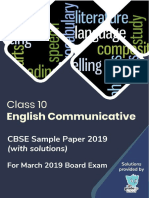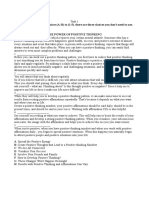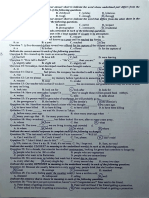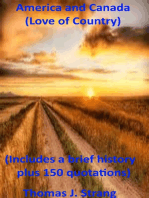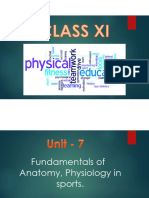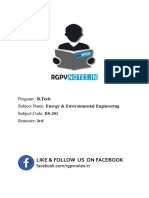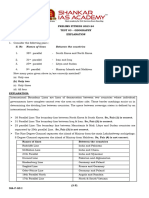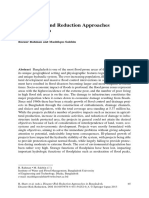Term 1 Class 9 10122021
Uploaded by
21- VARNIKA DALALTerm 1 Class 9 10122021
Uploaded by
21- VARNIKA DALALEnglish Term 1
Class – IX
Time: 90 Minutes Max. Marks 40
General Instructions:
1. The Question Paper contains THREE sections.
2. Section A-READING has 18 questions. Attempt a total of 14 questions, as per
specific instructions for each question.
3. Section B-WRITING & GRAMMAR has 12 questions. Attempt a total of 10 questions, as
per specific instructions for each question.
4. Section C-LITERATURE has 30 questions. Attempt 26 questions, as per specific
instructions for each question.
5. All questions carry equal marks.
6. There is no negative marking.
SECTION A -READING
I. Read the given passage carefully and choose the best answer from the given
alternatives:
(1) Politeness has been correctly defined as benevolence in trifles. It is the desire to put
people we meet perfectly at ease, and save them from every kind of petty discomfort and
annoyance. The limited part of benevolence called politeness requires only an inclination to
make people happy while they are in our presence. This can be done without any sacrifice on
our part or only with a slight sacrifice of personal comfort.
(2) Politeness is said to be one of the important characteristics of a civilised person. It must
be implemented in every walk of life. An honest and polite person is polite with everyone—
elders, people of lower status, workers, and even children. Not only with humans but we must
also be polite with animals.
(3) Politeness is a skill. Like any other skill, you can master it with practice. The greatest
enemy of politeness is ego. To be a polite person, you have to sacrifice your ego. It is
difficult for an egoist to be polite. You have to apply politeness in your thinking, speech, and
actions. Actions work more than words. Polite actions will give positive results. In our daily
lives, we come across many incidents where people are unnecessarily rude. Politeness will
reduce your stress and help you be productive. Apart from immediate benefits, you protect
your future as well. Being polite makes you mentally healthy.
(4) Different rules of behaviour have to be observed at different places, for example in the
street or in the drawing-room, at home or at school, in the company of friends or with
strangers. We must also consider the great diversity of social etiquette which distinguishes
one country from another.
(5) Politeness, besides being a duty that we owe to others, is also a valuable possession for
ourselves. It costs nothing, and yet may in many cases bring much profit. The great advantage
of this excellence of conduct was very clearly expressed by Dr Johnson when he said that the
difference between a well-bred and an ill-bred man is that one immediately attracts your
liking, the other your dislike.
On the basis of your understanding of the passage, answer ANY EIGHT questions from
the ten that follow:
1. Politeness requires:
A - ego
B - sacrifice of ego
C - happiness
D - politeness
2. Choose the option that best captures the central idea of the passage from the given quotes.
(1) ‘Politeness is the flower of humanity.’
—Joseph Joubert
(2) ‘Politeness, is the most acceptable hypocrisy.’
— Ambrose Bierce
(3) ‘One of the greatest victories you can gain over someone is to beat him at politeness.’
—Josh Billing
(4) ‘Punctuality is the politeness of kings.’
—Louis XVIII of France
A - option (1)
B - option (2)
C - option (3)
D - option (4)
3. What is the tone of the following context: “You have to apply politeness in your thinking,
speech, and actions.”?
A - egoistic
B - imperative
C- rude
D - angry
4. In which all areas should politeness be inculcated?
A - speech
B - speech, thought and actions
C - only actions
D - only thoughts
5. Which of the following sentences makes the correct use of ‘trifle’, as used in the passage.
A - We shouldn’t bother him over such trifles.
B - She must not be trifled with.
C - I want to have trifles in dessert
D – I was a trifle surprised at his strange behaviour.
6. How does the culture of different countries vary?
A - in social etiquette
B - in social behaviour
C - in social laws
D - in social drawbacks
7. What is politeness for us?
(1) duty (2) right (3) habit (4) valuable possession
A - option (1) only
B - options (1) and (2)
C - options (1) and (4)
D - options (2) and (3)
8. What do you understand from this line, ‘Politeness is said to be one of the important
characteristics of a civilised person.’?
A - Politeness is inevitable
B - Being polite is a quality of a civilized person
C - Don’t waste your time with civilized people
D - Try to be civilized
9. Choose the option that correctly states the meaning of ‘well-bred’ as implied in the
passage:
A - ill-bred
B - refined
C - excellence
D - profit
10. Choose an option that is the synonym of ‘petty’ as used in paragraph 1 of the passage
A. pretty
B. small and unimportant
C. true
D. great
II. Read the given passage given below.
Nepal lies between India and Tibet, among the Himalayan Mountains. The tallest mountain in
the world, Mount Everest, is in Nepal, and there are several mountains nearly as high. When
mountaineers try to climb Mount Everest, they take the help of the Sherpas, the strong and
hardy people who live in these mountains, to carry heavy loads and to act as guides.
A long time ago, the Sherpas crossed over the mountains from Tibet and made their homes
along the southern slopes of the Himalayas in Nepal.
Some Sherpa families have three houses, one house in the lower hills, one a little higher, and
one further up. The houses are in small village groups of about forty or fifty. Round each group
of houses there are cultivated fields, usually built in the shape of terraces right up the hillsides.
In the highest fields the Sherpas grow potatoes; in the lower fields they grow barley; and
turnips, garlic and other vegetables in the lower ones. They also graze their yaks on the higher
mountain slopes in the summer and on the lower slopes in the winter. Yaks are very hardy,
large cattle with thick, hairy blackish-brown coats and long horns. The Sherpas use them for
almost everything they need. They ride them, plough with them, and use them to carry their
goods. The hairy wool of these animals is made into cloth and their skins into leather boots and
tents. The yaks also provide milk, fat and meat. Their dung is dried and used as fuel instead of
wood or coal.
On the basis of your understanding of the given passage, answer ANY SIX
questions from the eight that follow.
11. Where is the location of Nepal?
A- between Mount Everest and Tibet
B- between Tibet and India
C- between Tibet and Himalaya
D- between Tibet and Mount Everest
12. Sherpas are not known for:
A - their strength and hardness
B - for cunningness
C - their carrying heavy loads
D - acting as guides
13. Where do the Sherpas have their houses?
A - on the lower hills
B - one a little higher
C - another a little higher up
D - all the three above
14. Sherpas do not grow on the lower fields:
A - potatoes
B - turnip and garlic
C - other vegetables
D - barley
15. What are the things for which yaks are not used?
A - their skins into leather boots and tents
B - wool of these animals is made into cloth
C - for sports
D - to carry their goods.
16. Find a word from the passage similar to the word ‘cultivate’.
A - graze
B - plough
C - terraces
D – cattle
17. Find a word from the passage similar to the word ‘turfs’.
A - terraces
B - fields
C - houses
D - mountains
18. Find a word from the passage opposite of the word ‘hardy’.
A - resilient
B - enduring
C - delicate
D - foolhardy
SECTION B_- GRAMMAR & WRITING
III. Question No. 19 to 24 are based on the given text. Read the text carefully and
answer ANY FIVE of the questions:
Story writing is an art. It is the oldest form of written composition. It is an account
of imaginary or real people and events told for entertainment. It casts magic spell
on all of us and have mind-altering effects.
Q.19: A short story, basically is,
A- an imaginary piece
B- all of these
C- with comprehensible grammatical structure
D- direct and brief
Q.20: Which of the following is not an element of a short story?
A- Conflict
B- Character
C- Context
D- Climax
Q.21: There is a hero or heroine who is the centre of the story, around which the plot
revolves. What is it usually called?
A- Leader
B- Protagonist
C- Role play
D- Anti-Hero
Q.22: Which is an incorrect option regarding the setting of a story?
A- Time and Place
B- Landscape and Scenery
C- Season and Weather
D- Incidents and Actions
Q.23: ____________is the central idea or belief of the story.
A- Plot
B- Conflict
C- Theme
D- Setting
Q.24: When does the plot of the story begin to move towards the end?
A- After the climax
B- Before the conflict
C- During the conflict
D- After the resolution
IV. Answer ANY FIVE out of the six questions given below.
Q.25: I___________ tennis yesterday.
A- played
B- will play
C- have played
D- play
Q.26: There ________more calories in a bowl of chocolate-broccoli breakfast cereal than you
might think.
A- are
B- is
C- were
D- will be
Q.27: She___________ work a little harder.
A- could
B- ought to
C- may
D- might
Q.28: According to the studies, dolphins, whales and __________ other sea creatures use
highly sophisticated navigation systems.
A- much
B- many
C- each
D- any
Q.29: "I am leaving the city tomorrow," the lecturer said.
He said that ____________leaving the city__________
A- he is, tomorrow
B- he was, the following day
C- he was, that day
D- I was, previous day
Q30. The teacher said. "The wind is a renewable energy source."
A- The teacher said that the wind was a renewable energy source
B- The teacher said that the wind is a renewable energy source.
C- The teacher told that the wind is a renewable energy source.
D- The teacher tells that the wind was a renewable energy source.
SECTION C – LITERATURE
This section has sub-sections – V, VI, VII, VIII & IX. There are a total of 30 questions
in this section. Attempt 26 questions from the sub-sections V to IX.
V. Read the given extract to attempt the questions that follow:
She has brought percussion to the front of the orchestra and demonstrated that it can
be very moving. She has given inspiration to those who are handicapped, people who
look to her and say, “If she can do it, I can.” And, not the least, she has given enormous
pleasure to millions.
Q 31 Who does ‘she’ refer to here?
A. Evelyn Glennie
B. Everlyn Glennie
C. Evelyn Glemmie
D. none of these
Q32 How did the handicapped draw inspiration from her?
A. She helped them monetarily.
B. She used her influence to help them.
C. They felt if she could achieve success, then so could they.
D. She taught all of them to play musical instruments.
Q33 What handicap did ‘she’ have?
A. She was blind
B. She was deaf
C. She was dumb
D. She was unable to walk
Q34 The word ‘percussion’ is a musical instrument that is
A. Sounded by being struck or scraped
B. Sounded by being blown into
C. Played using a keyboard
D. Sounded by plucking at the strings
Q35 The passage shows that ‘she’ was
1. Determined
2. Lazy
3. Hardworking
4. Selfish
5. Inspiring
A. 1, 2 and 3
B. 1, 3 and 5
C. 3, 4 and 5
D. 2, 4 and 5
VI. Read the given extract to attempt the questions that follow:
On the whole, the small society of Rameshwaram was very rigid in terms of the
segregation of different social groups. However, my science teacher Sivasubramania
Iyer, though an orthodox Brahman with a very conservative wife, was something of a
rebel. He did his best to break social barriers so that people from varying backgrounds
could mingle easily.
Q 36 What kind of a society did Rameshwaram have?
A. accommodating
B. inflexible
C. broadminded
D. rebellious
Q.37 The science teacher was a man with
A. novel ideas
B. run of the mill ideas
C. unorganized ideas
D. discouraging ideas
Q.38 Which word in the extract is closet in meaning to ‘mix’
A. segregation
B. orthodox
C. varying
D. mingle
Q39 Sivasubramania’s wife was initially very
A. hospitable
B. traditional
C. maverick
D. independent minded
Q40 The science teacher was a
A. Muslim
B. Sikh
C. Brahman
D. Christian
VII. Read the given extract to attempt the questions that follow:
He won’t do what you tell him
So, come, let’s build strong homes,
Let’s joint the doors firmly.
Q.41 Who does ‘he’ and ‘him’ in line 1 of the reference refer to?
A. rain
B. snake
C. wind
D. fire
Q.42 Which traits of ‘him’ are evident from these lines
1. foolish
2. strong
3. violent
4. meek
5. self willed
A. 3 & 4
B. 1, 3 & 5
C. 1 & 3
D. 2. 3 & 5
Q.43 What advice does the poet offer to the readers?
A. to strengthen themselves in all aspects
B. to flee from there
C. to stay behind locked doors
D. to disregard ‘his’ strength completely
Q44 What happens to the doors not joined firmly?
A. They get destroyed by the force
B. They are unable to withstand the onslaught.
C. The hinges hold good
D. Both A and B
Q45 Which of the following is the most apt antonym of ‘firmly’?
A. weakly
B. weekly
C. steadily
D. slowly
VIII. Read the given extract to attempt the questions that follow:
The stake is the stake of the god of justice. It’s new, it has never had a criminal on it.
Whoever dies on it first will be reborn as the king of this country. And whoever goes
next will be the future minister of this country.
Q.46 Who speaks these lines and to whom?
A. The king to the guru
B. The Guru to his disciple
C. The Guru to the king
D. The king to his subjects
Q47 What does ‘stake’ mean here in this context?
A. Something that is put up to be won or lost in gambling
B. A post to which a person is tied to be put to death
C. A poison that kills on consumption
D. None of these
Q.48 Why did the speaker call the stake ‘the stake of the god of justice’?
A. He was a deeply religious man.
B. He was greedy and wanted to grab the power of governance.
C. He wanted to fool the listener into believing him.
D. He was making a guess.
Q49 What did the guru claim would happen to the person who was put on the stake first?
A. He would go to heaven.
B. He would be reborn as the king of that country.
C. He would become the god of justice.
D. Both A and C.
Q.50 Who eventually was put on the stake first?
A. the Guru
B. the disciple
C. the minister disguised as the Guru
D. the king disguised as the Guru
IX. Attempt the following.
Q.51 Margie felt that the old schools must have been fun because
A. The kids learnt the same things so they could help one another
B. They must have sat together in the school room, laughed and shouted together in the
school yard
C. The teachers were people
D. All the above
Q.52 Dumraon held a special place in the heart of Bismillah Khan because
A. He had played marbles there as a four year old
B. He stayed there at his maternal uncle’s house
C. He played shehnai at the temples of Balaji and Mangala maiya there
D. He sang the Bhojpuri ‘Chaita’ at the nearby Bihariji temple.
Q.53 Kezia realized that her father had a big heart when
A. He beat her with a ruler for tearing his speech for the Port Authority
B. She saw the Macdonalds next door, playing ’tag’.
C. He carried her to his bedroom after she had a nightmare and she snuggled her head
under his arm.
D. On Sunday afternoons she went to the drawing room to have a nice chat with her parents.
Q.54 “And the melancholy darkness
Gently weeps in rainy tears.”
The literary device in ‘melancholy darkness’ is
A. Alliteration
B. Transferred epithet
C. Onomatopoeia
D. Simile
Q.55 Albert Einstein was celebrated as a visionary and world citizen because
A. He lived in several places across the world.
B. He was a scientific genius.
C. He made it big despite not being able to talk till the age of two and a half years.
D. He propagated democracy and peace.
Q56 The poem ‘A Legend of the Northland’ is a
A. Ballad
B. Sonnet
C. Free Verse
D. Epic
Q.57 In the lesson ‘The Lost Child’ the child lost his parents near
A. the flower seller
B. the snake charmer
C. the roundabout swing
D. the balloon seller
Q.58 Which of the following traits apply to Toto?
1. Intelligent
2. Mischievous
3. Dull
4. Obedient
A. 3 and 4
B. 2 and 3
C. 1 and 4
D. 1 and 2
Q.59 “As he is no longer beautiful he is no longer useful.” Who made this statement in the
lesson ‘The Happy Prrince’?”
A. The Art Professor at the University
B. The Mayor
C. The Town Councillors
4. The swallow
Q60. On what condition did the disciple and his Guru agree to rule the kingdom?
A. They would change all the old rules.
B. All things would be sold at the same price
C. They would never be ousted as the rulers.
D. Their children would continue to be the rulers after them.
You might also like
- PART 1. Choose The Best Answer For Each Question.: C. CraveNo ratings yetPART 1. Choose The Best Answer For Each Question.: C. Crave6 pages
- 10 English Communicative CBSE Sample Papers 2019 PDFNo ratings yet10 English Communicative CBSE Sample Papers 2019 PDF8 pages
- X English Communative SQP 2018-19.PDF-66No ratings yetX English Communative SQP 2018-19.PDF-6619 pages
- Class X English-Communicative (Code 101) (SAMPLE PAPER 2017-18)No ratings yetClass X English-Communicative (Code 101) (SAMPLE PAPER 2017-18)6 pages
- Class X English Communicative (101) Sample Question Paper 2018-19 Time Allowed: 3 Hours Max. Marks: 80 General InstructionsNo ratings yetClass X English Communicative (101) Sample Question Paper 2018-19 Time Allowed: 3 Hours Max. Marks: 80 General Instructions11 pages
- Class X English Communicative (101) Sample Question Paper 2018-19 Time Allowed: 3 Hours Max. Marks: 80 General InstructionsNo ratings yetClass X English Communicative (101) Sample Question Paper 2018-19 Time Allowed: 3 Hours Max. Marks: 80 General Instructions6 pages
- TMS - MRT - GR - X - Pre Term 2 - 2021-22 English - QPNo ratings yetTMS - MRT - GR - X - Pre Term 2 - 2021-22 English - QP5 pages
- English - Compulsory (Paper B) - Annual 2013 - IINo ratings yetEnglish - Compulsory (Paper B) - Annual 2013 - II2 pages
- Class X English-Communicative (Code 101) (SAMPLE PAPER 2017-18)No ratings yetClass X English-Communicative (Code 101) (SAMPLE PAPER 2017-18)6 pages
- IX English Model QP Term 2 - SET 2 FINAL-1No ratings yetIX English Model QP Term 2 - SET 2 FINAL-13 pages
- Applied English Grammar Composition CBSE Sample Paper 2No ratings yetApplied English Grammar Composition CBSE Sample Paper 26 pages
- Computer Operator Contract Under Sad 2016 General EnglishNo ratings yetComputer Operator Contract Under Sad 2016 General English8 pages
- Mark The Letter A, B, C, or D On Your Answer Sheet To Indicate The Word Whose Underlined Part DiffersNo ratings yetMark The Letter A, B, C, or D On Your Answer Sheet To Indicate The Word Whose Underlined Part Differs18 pages
- Question Bank of English Vii Mani - Ram TezpurNo ratings yetQuestion Bank of English Vii Mani - Ram Tezpur68 pages
- 50 de Dot Pha Tieng Anh Diem 9 Bo de Thi Vao 10 Bui Van Vinh Co Dap AnNo ratings yet50 de Dot Pha Tieng Anh Diem 9 Bo de Thi Vao 10 Bui Van Vinh Co Dap An226 pages
- Class X English-Communicative (Code 101) (SAMPLE PAPER 2017-18)No ratings yetClass X English-Communicative (Code 101) (SAMPLE PAPER 2017-18)6 pages
- CBSE Class 10 English Question Paper 2018 Embibe50% (2)CBSE Class 10 English Question Paper 2018 Embibe12 pages
- CBSE Class 10 English Communicative Question Paper 2017 PDFNo ratings yetCBSE Class 10 English Communicative Question Paper 2017 PDF16 pages
- 35 Đề Minh Họa 2020 - Edited - Tests 1-10No ratings yet35 Đề Minh Họa 2020 - Edited - Tests 1-1045 pages
- De Hoc Sinh Gioi Tieng Anh 11 Nam 2022 2023 Truong THPT Phung Khac Khoan Ha NoiNo ratings yetDe Hoc Sinh Gioi Tieng Anh 11 Nam 2022 2023 Truong THPT Phung Khac Khoan Ha Noi11 pages
- The Moral Compass: Finding Balance and Purpose in an Imperfect WorldFrom EverandThe Moral Compass: Finding Balance and Purpose in an Imperfect WorldNo ratings yet
- Electrostatic Potential and Capacitance-JEENEETNo ratings yetElectrostatic Potential and Capacitance-JEENEET2 pages
- On Killing A Tree - Question and AnswersNo ratings yetOn Killing A Tree - Question and Answers3 pages
- Prachi Essay Himalayan Earthquake in 2005No ratings yetPrachi Essay Himalayan Earthquake in 20055 pages
- 1973 The Rise of The House of Gorkha by Stiller SNo ratings yet1973 The Rise of The House of Gorkha by Stiller S406 pages
- Full Environmental Geography of South Asia Contributions Toward A Future Earth Initiative 1st Edition R.B. Singh PDF All Chapters100% (5)Full Environmental Geography of South Asia Contributions Toward A Future Earth Initiative 1st Edition R.B. Singh PDF All Chapters62 pages
- Transcripts - Forever Dreaming - 01x02 - Mountains - Planet Earth INo ratings yetTranscripts - Forever Dreaming - 01x02 - Mountains - Planet Earth I6 pages
- Class Ix Question Bank Geography Chapter – 3 DrainageNo ratings yetClass Ix Question Bank Geography Chapter – 3 Drainage4 pages
- Unit 3 - Energy & Environmental Engineering - WWW - Rgpvnotes.inNo ratings yetUnit 3 - Energy & Environmental Engineering - WWW - Rgpvnotes.in25 pages
- 03 Physical Divisions of India, Himalaya Vertical Division 03 01No ratings yet03 Physical Divisions of India, Himalaya Vertical Division 03 0165 pages
- VisionIAS Quick Revision Material December 2024 Prominent Protected AreasNo ratings yetVisionIAS Quick Revision Material December 2024 Prominent Protected Areas25 pages
- Revision Assignment Class Ix Geo - Eco 1No ratings yetRevision Assignment Class Ix Geo - Eco 12 pages
- Volume - 3 - Tech Specifications - Package-5 13.09.2021No ratings yetVolume - 3 - Tech Specifications - Package-5 13.09.2021189 pages
- Gangtok - Darjeeling 6 Nights 7 Days Sanket BhaiNo ratings yetGangtok - Darjeeling 6 Nights 7 Days Sanket Bhai6 pages
- E.V.S Unit 4 Biodiversity and ConservationNo ratings yetE.V.S Unit 4 Biodiversity and Conservation11 pages
- Flood and Risk Reduction Approches in BangladeshNo ratings yetFlood and Risk Reduction Approches in Bangladesh26 pages



